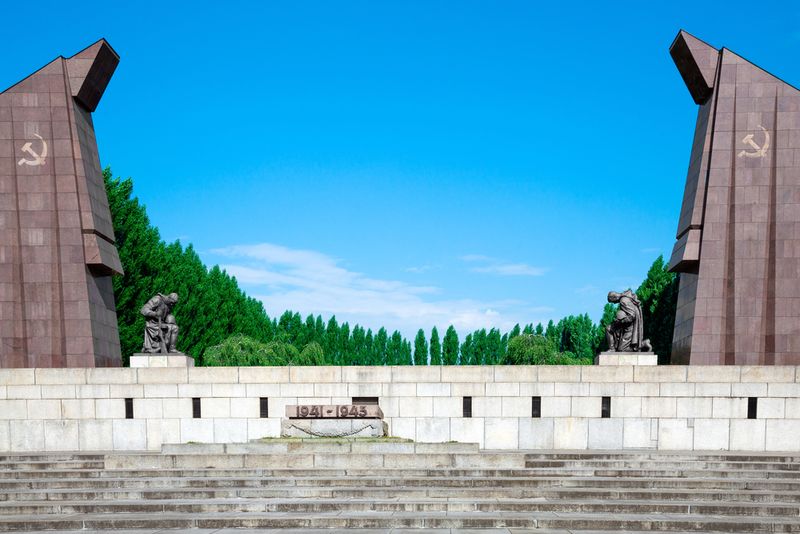
If you’re a World War II aficionado or history buff in general, there’s no other trip quite like seeing the sights left behind by the Third Reich and Nazi Germany. Some were bombed into obsolescence, others were destroyed to cover over the reminder of the atrocities of war, but many significant spots remain accessible to the public today. Here are 10 historically significant WWII sites to see in Germany:
Advertisement
1. Vorbunker/Führerbunker -Berlin
Vorbunker and Führerbunker were once the places where Adolf Hitler took shelter and eventually lived. The elaborate underground concrete bunker complex was designed to be a temporary air-raid shelter for Hitler, his family and his guards. While the site has been redeveloped into the current residential housing that stands today, this remains an important place of WWII significance as it was in the Führerbunker that Hitler committed suicide. Today a commemorative sign can be seen explaining the layout and significance of the bunker complex.

2. Dachau Memorial and Museum -Dachau
Dachau was the first of many Nazi concentration camps opened in Germany and was designed to hold political prisoners from Germany and Austria as well as Jewish prisoners. It was also open the longest, from March 1933 to April 1945 spanning nearly all 12 years of the Nazi regime. Today the site of the former concentration camp is home to a memorial as well as a museum and can be visited by the public.

3. Nazi Party Rally Grounds -Nuremberg
The rally grounds of the Nazi party covered about 11 square kilometers in Nuremberg’s southeast and were the site of six Nazi rallies between 1933-1938. While not all of the historic buildings remain, many are preserved and can be visited by the public as the entire site is now a memorial.

4. Holocaust Memorial -Berlin
This 4.7 acre site in Berlin was designed by architect Peter Eisenman and engineer Buro Happold and serves as a tribute to Jewish victims of the Holocaust. The site is covered with 2,711 concrete slabs known as ‘stelae’ and includes a Place of Information on the site’s eastern edge which lists the names of all known Jewish Holocaust victims.

Advertisement
5. St. Nicholas’ Church -Hamburg
This Gothic Revival church was once the tallest building in the world from 1874-1876 and played an important role in WWII. During the extensive air raids on the city of Hamburg, the church tower served as a goal and visual orientation marker for the Allied Air Forces. Unfortunately, on July 28, 1943 the church was severely damaged by bombing and was reduced to the only remaining tower which can still be seen today.

6. Kehlsteinhaus (Eagle’s Nest) – Obersalzberg
The Kehlsteinhaus or ‘Eagle’s Nest’ as it’s known in English speaking countries is a Third Reich-area complex that was given to Adolf Hitler for his 50th birthday as a retreat to entertain friends and guests. The Kehlsteinhaus sits on a rocky outcrop known as Obersalzberg near the town of Berchtesgaden. Today the Eagle’s Next can still be visited by the public as it houses a restaurant, beer garden and tourist site.

7. Colditz Castle -Colditz
Colditz is a Renaissance castle located in Germany’s Saxony state. During WWII the castle was converted and used as a high security prisoner-of-war camp for officers who were particularly dangerous or were regarded as escape risks. The German’s believed the castle’s location on a rocky outcrop above the River Mulde made it an excellent spot for a high security prison, however Colditz POW camp had one of the highest records of successful escape attempts during WWII.

8. Mittelbau-Dora Memorial -Nordhausen
Mittelbau-Dora was a WWII Nazi concentration camp located near Nordhausen in the German state of Thuringia. This camp was notorious for its extreme cruelty towards prisoners and roughly 1 in 3 of the 60,000 prisoners sent here did not survive. Today the site is home to a memorial and history museum and serves as a place of mourning and commemoration of the victims of this concentration camp.

Photo by: Buchewald and Mittelbau-Dora Memorials Foundation
9. Soviet War Memorial -Berlin
The Soviet War Memorial is located in Berlin’s Treptower Park and was build to commemorate the Soviet soldiers who fell during the Battle of Berlin in 1945. The main feature of the memorial is a 12-m tall statue of a Soviet soldier with a sword holding a German child, standing over a broken swastika. The central area before the monument is lined with 16 stone sarcophagi, one for each of the 16 Soviet Republics. Each of the sarcophagi are adorned with carvings of military scenes and quotations from Joseph Stalin in both Russian and German languages.

Advertisement
10. Besseringen B-Werk -Merzig
The Besseringen B-Werk is the only completely preserved fortification bunker located in the Siegfried Line; a 630 kilometer defensive system built between 19 and featured more than 18,000 bunkers, tunnels and tank traps. 32 bunkers in the Seigfried Line were built to construction standards or thickness ‘B’ hence the term B-Werk. Post-war, the site was used as a rubbish dump but it was restored and opened in 2005 as a museum which can be visited by the public today.

Like this? Check out 15 Must See World War II Sites in Europe
Advertisement